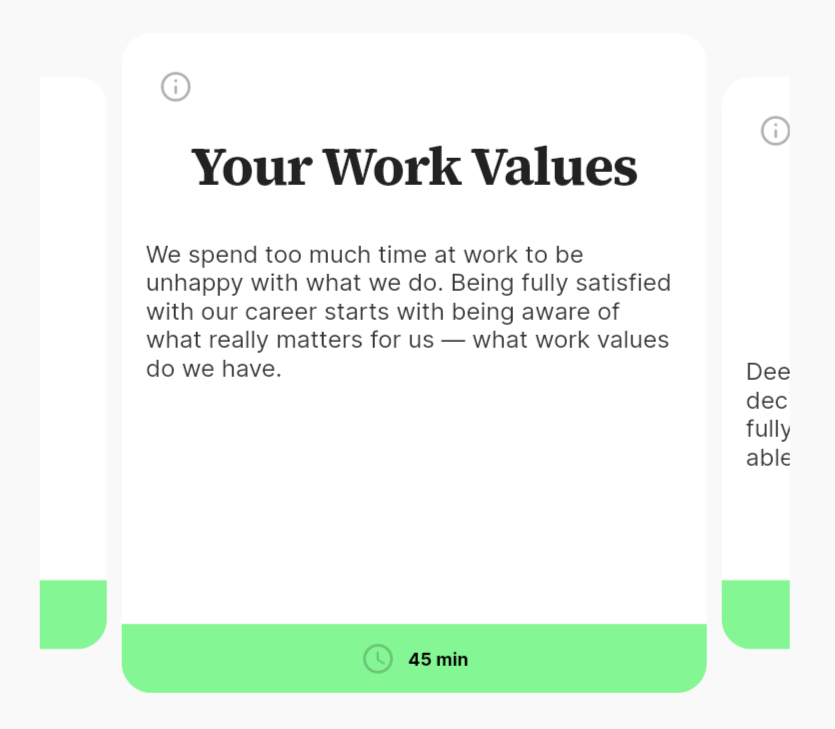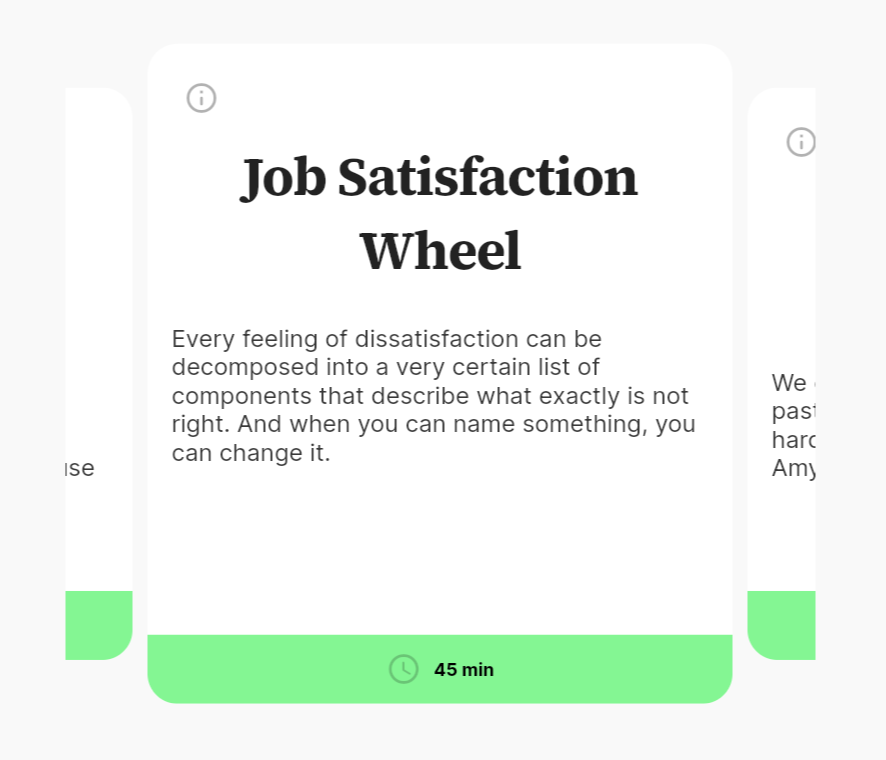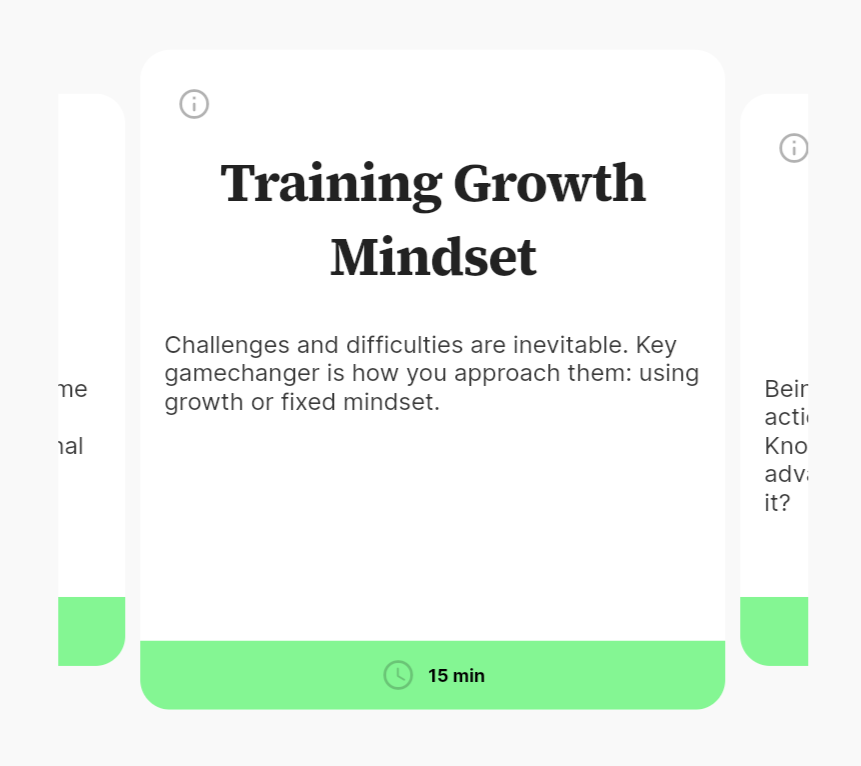The power of career self-coaching lies in proven techniques shaped by career coaching experts. The techniques promote clarity in a career path to follow the desired direction and be open to new opportunities. How can you prepare for self-coaching? Where can you start? Let’s tackle the basics and review three techniques in the form of exercises you can take on the Amy platform.
The story of career self-coaching behind the article
Emma is a UX/UI designer with years of experience in product design at big tech companies. She grasps a mass of positive feedback from clients and their customers. She highly simplifies the use of a product, especially in the fields of FinTech and Healthcare, and has striking use cases. May seems impressive, isn’t it? On the flip side, Emma manifests better assertiveness skills and a hard stop at 6 PM. She is overly dedicated and sacrifices other life areas for her career. Plus, she tends to tolerate criticism poorly and take it personally.

Emma isn’t flexible and risky when it comes to career transition. She prefers staying in a single, safe place but, at the same time, needs a career format change because of her current tough schedule. Maybe freelance or smaller company with fewer responsibilities.
We will show Emma’s example through three techniques.
Preparation: Ask yourself questions
When you get into career coaching, the first thing worth doing is to ask yourself questions. The practice is called journaling and involves writing down the answers to understand your motivations and challenges—and, first of all, what you feel. Take the following:
- Interests: What are my interests and passions? Are my interests present in my job, or are they outside my role? What are my life values?
- Preferences: What do I like and dislike most about my job? What does my perfect work environment look like? What is my perfect schedule?
- Achievements: How do I define success and measure my progress? How can I celebrate my achievements? What have been my biggest career achievements?
- Inspirations: What inspires me to pursue my career goals?
- Challenges: How do I handle challenges? Can I handle them alone, or do I need support and guidance? Do I face any challenges with my current job? Is there anything that holds me back in my career? How do I address the situation?
- Risks: What risks can I take for my career? Am I ready for changes and to step out of my comfort zone?
- Lessons learned: What have I learned from my career experience or previous jobs?
You can expand the list to fit your unique case or even personalize the questions. Journaling formats also vary. A pocket notebook or digital, like an app or an online platform—choose based on what suits you best.
Make the journaling practice a regular activity or build a foundation for your further career coaching exercises that we will move on to in the next sections. As a regular activity, spend a few minutes every morning, after lunch, or in the evening. For example, start each morning with a quick note of your intentions and goals or write down your day’s experiences before bed. Midday check-in helps reflect on progress.
Technique 1: Your work values
If you live in harmony with your work values, you are satisfied with your occupation and break through barriers without a doubt.
The technique called Your Work Values sticks to the three groups of values:
- Core principles like ambition, honesty, or status
- Relationships and people like respect, trust, or leadership
- Work activities like quality, innovativeness, or contribution

You choose the ones that resonate most with you—whether you are in a team of autonomy, managing your schedule, or prefer the leadership of skillful managers. You rate your work values to indicate how much the value is present at your current job.
Take a look at Emma’s work values map:
General:
- Achievements: the ability to reach goals (8/10 various projects available in the pool, but not enough time for learning and upskilling)
- Work-life balance in work time and leisure time (4/10 because of overtimes and work on weekends)
- Passion: work that evokes enthusiasm and drive (10/10 UI/UX design is my calling)
Relationships:
- Recognition: acknowledgment of contribution (10/10 based on the amount of feedback received)
- Empathy: the ability to empathize with others and understand their situations and problems (8/10 managers don’t always consider personal circumstances, for overtime activities including)
- Teamwork: encouragement of collaborative work on projects and tasks (10/10 admiringly collaborative work environment)
Work:
- Quality: work that has high quality (10/10 as I try my best and have successful case studies)
- Creativity: work that needs creative abilities (10/10 creative tasks smoothly balance technical activities)
- Assistance: work that is aimed at helping people (10/10 I turn complex product solutions into designs straightforward to customers)
Emma needs to reflect on her work-life balance and communication with her manager. Is it possible to make this value more present in a current job? What small step can she take today to open doors to the change?
The Your Work Values exercise provides clear names and definitions to bring yourself closer to a more meaningful and fulfilling life.
Technique 2: Job satisfaction wheel
Job Satisfaction Wheel covers various areas of your work to rate and clarify what really matters to you and what you can tolerate. Job satisfaction assessment emphasizes action items to improve your current state in career development.
Once you rate areas, the Job Satisfaction Wheel gives you a clear view of your job satisfaction level. Take time to analyze where you have the lowest rates among aspects like:
- Work environment
- Freedom and autonomy
- Compensation
- Learning and growth opportunities
What can you do this week to improve them?

Job satisfaction wheel example
We will use Emma’s experience while working in a big tech company.
Rating:
- Work environment: 5/10 (the collaborative team but high stress and long hours)
- Freedom and autonomy: 5/10 (limited autonomy in decision-making)
- Compensation: 10/10 (financially stable)
- Learning and growth opportunities: 4/10 (limited room for growth in the current setup)




Action plan:
Joining a smaller company can enhance job autonomy but might impact compensation. However, Emma can start with:
- Developing a personal brand: build an online presence by sharing design works on Dribble and Behance platforms to position herself as an expert.
- Start as a part-time freelancer: begin freelancing to test the waters.
Regularly using the Job Satisfaction Wheel helps easily spot imbalances in a job, create and follow an action plan, and track how changes impact overall career satisfaction.
Technique 3: Training growth mindset
“The key factors for successful self-coaching or personal growth work would be one’s ability to deep reflective practice as well as the growth mindset (as per Carol Dweck’s book “Mindset: The New Psychology of Success.”).”
At its core, a growth mindset means believing that you can develop your talents leads to greater success than thinking your abilities are fixed and cannot be improved. For example, Stanford University’s study about Growth Mindset and Enhanced Learning finds that when students have a growth mindset, they are more likely to challenge themselves, believe that they can achieve more, and become stronger, more resilient and creative problem solvers.
With the Training Growth Mindset technique, you build the ability to overcome difficulties, embrace continuous learning, and foster a proactive attitude towards growth. In the exercise on the Amy platform, you will examine sample cases to practice how to address the situations, training your positive thinking and decision-making skills.

Training growth mindset example
- As an experienced designer, Emma might believe she has mastered all possible techniques, and learning new ones feels overwhelming, especially with her schedule overloaded with tasks.
Growth mindset approach: challenge yourself to embrace new technologies as opportunities for growth, even if it initially feels uncomfortable.
Action: set a small monthly learning goal, like microlearning for mastering AI UX trends, and apply what you’ve learned to projects.
Result: “Even though I’ve been working in the UI/UX field for years, trying new patterns will push me to think creatively and keep my skills current.” - Emma struggles to handle criticism and not to take it personally, which impacts her confidence.
Growth mindset approach: View criticism as a headway, not as a reflection of your worth as a designer.
Action: After receiving constructive criticism, ask follow-up questions to understand the feedback better. This helps to accept feedback as an essential part of professional growth.
Result: “The feedback I get isn’t a personal attack. It is about the design mockup. I can improve the part the client talks about by making adjustments.”
Practice self-coaching exercises
In addition to goal-setting and actionable strategies, career coaching makes you reflect on your past and current path, as self-reflection is the foundation of the first two. The self-coaching techniques like Your Work Values, Job Satisfaction Wheel, and Training Mindset Growths boost confidence, foster resilience, and facilitate decision-making for a fulfilling career path.
If you are striving for a new job, a career change, or a promotion, self-coaching equips you with the tools to have the career you envision. Start with Amy’s self-coaching exercises today for your professional and personal growth.
